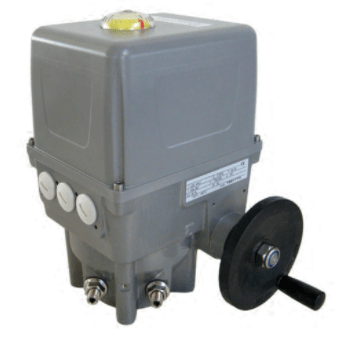Baelz Electric Rotary Actuator
Motorized rotary actuator baelz 375-E42
Motorized rotary actuator with load-dependent and travel-dependent limit switches. Input signal: 3 point.
| Torque | 150 Nm |
| Dimensions | 220 x 172 x 253/278 mm |
| Weight | 7.5 kg |
| Actuating speed | 60 s/90° |
| Protection class | IP 65 |

Baelz Electric Rotary Actuator
Electric rotary actuators are designed to convert electrical energy into controlled rotational force (i.e., torque) to move a specific mechanical device or system. They can be used to initiate or stop rotary motion, depending on how they are installed and controlled. Numerous variations are available to suit different applications. Typically, they are intended to be used for the rotary adjustment of valves.
The new Baelz electric rotary actuator, model 375-E42, is a replacement for the older actuator model 375-E41.
Features of Electric Rotary Actuators
The 375-E42 electric rotary actuator is controlled by three-point control or constant-control in conjunction with a 7020A digital positioner board. It is suitable for flow control applications requiring 90-degree rotation. Key actuator features include:
- Crank wheel that can be utilized one-handed or without the use of a clutch
- Travel-dependent and/or torque-dependent limit switches that can be individually configured
- Automatic dampers that open and close to regulate temperature
The Baelz 373-E42 is a motorized rotary actuator for flow control applications requiring a 90° rotation, such as those using drive butterfly valves or ball valves. The actuators are designed for highly accurate positioning in an industrial environment. Manual adjustment can be carried out one-handed and without use of a clutch. The travel-dependent and/or torque-dependent limit switches can be individually configured.
- The rotational element. Both circular shafts and tables can serve as rotational elements. Shafts typically have keyways to prevent unwanted relative movement between the shaft and attached components, while tables typically have a bolt circle/pattern to allow for the mounting of other components. Key dimensions for both include diameter and height.
- The angle adjustment mechanism. The angle of electric rotary actuators may be adjusted in a number of ways. Some use stop adjustment mechanisms (e.g., screws), while others use other devices to adjust the angle on both ends of the stroke.
- The handwheel. Handwheels provide manual override functionality to allow users to stop operations in the event of an emergency.
Applications for Electric Rotary Actuators
The actuators are suitable for installation in industrial plants and in waterworks and power plants with a low pollutant concentration. Baelz rotary actuators are for use outdoors or in an environment with a high pollutant concentration such as:
- heavy traffic areas
- industrial areas (chemical plants, sewage plants, etc.)
- coastal areas
- vessels on the open sea
The actuators must have external parts made of non-corrosive material and must be provided with a special coating. When used outdoors, the actuator must be protected with an additional cover against:
- rain
- direct sunlight
- strong draughts
- dust
Electric Rotary Actuators From Baelz NA
At Baelz NA, we are a premier manufacturer and distributor of quality control components. Our 375-E42 electric rotary actuator, when used in conjunction with our 7020A digital positioning board, allows industry professionals to maintain precise control over the rotary adjustment of valves. To learn more about electric rotary actuators and our relevant product offerings, contact us today. For specific product questions or pricing details, request a quote.
